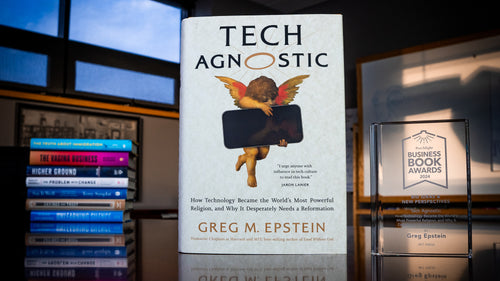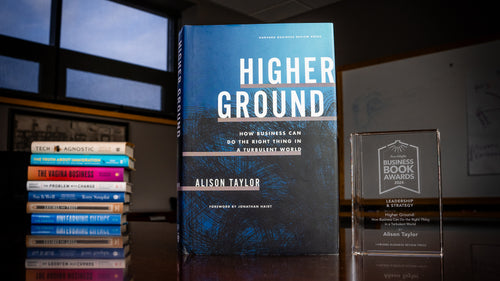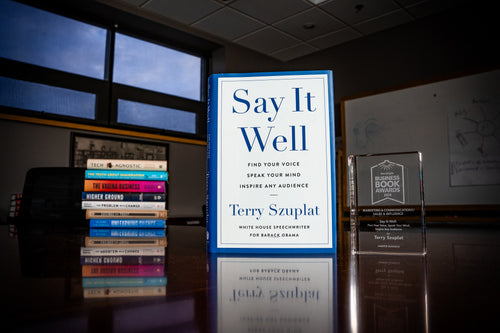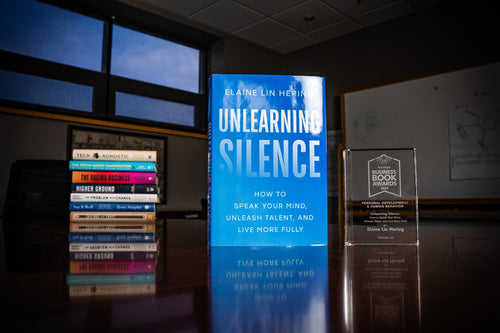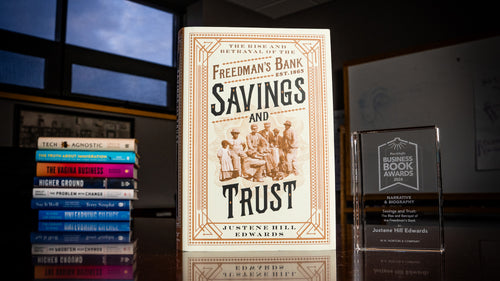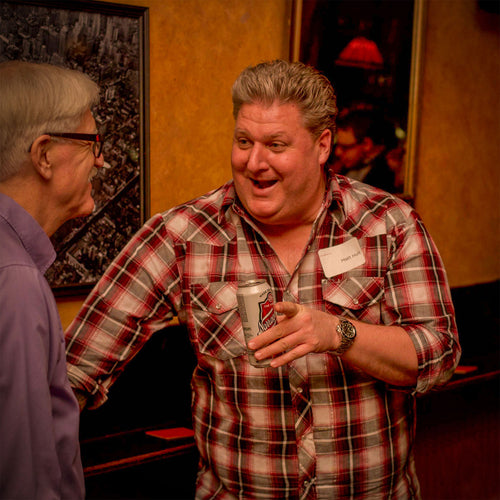The Promises of Giants | An Excerpt from the 2021 Porchlight Leadership & Strategy Book of the Year
The 2021 Porchlight Leadership & Strategy book of the year is The Promises of Giants by John Amaechi.
Unlike many leadership books, it was written with the understanding that all of us, regardless of our titles, wield influence and have the ability to lead. It is "rooted in the belief that the most unlikely of people, in the most improbable of circumstances, can become extraordinary." Amaechi suggests fourteen promises we should all make in that effort, promises that honor others' humanity and inherent dignity, and help us take greater care in how we exercise our influence so it is deliberately productive and positive rather than unintentionally harmful to individuals around us and the organizations of human beings we work with.
The following excerpt comes from Chapter 8, the eighth promise, "I Promise to See You as an Individual and Not as a Job Description."

We cannot lose sight of humanity and individualism. We must promise to see more in our people than just what is outlined in their job descriptions. Organizational culture depends upon it. Realizing the full potential of our people depends upon it. And, ultimately, winning depends upon it.
But there are factors that work against us and make it difficult to fulfil this promise. I have already mentioned the stultifying effect of bureaucratic processes and policies that numb the mind and are often unnecessary. Further, though, as we become more skilled in the technical demands of our work and more familiar with the routines of our workplaces, there is a natural tendency toward desensitization. It becomes easier to put on blinders and operate on autopilot when carrying out responsibilities that have become habitual. Add to this toxic stew the cult of busy, which mandates that all serious professionals look and sound like they have no time to breathe, and you have a recipe for disaster.
Again, it is fascinating to watch this ironic evolution in the modern working world—the development of artificial intelligence and the creation of generic, almost cookie-cutter-like workforces. We are mining data at an unprecedented rate and creating ever smarter algorithms in an effort to mimic human intelligence. And meanwhile we are operating with policies, procedures, language, an approach to people, and fixed mindsets around inclusion and human capability that transform people into predictable, indistinguishable, and ultimately disposable automatons. We are living in a time in which our brightest minds are trying to create human-like machines while making people themselves more machine-like. But wait—it gets worse!
Traditionally, most corporate entities—not all, but most—have been triangular in structure and hierarchy. At the top, you have a small group of “elite” leaders, who generally make the most money while arguably contributing the least. At the bottom, you have that indispensable bedrock of the rank and file who are keeping the wheels turning. That’s where the grunts are doing the real dirty work and, in doing so, mastering skills and developing critical competencies. And, ideally, the best and brightest from that group will ascend into that center layer of the triangle that we sometimes refer to dismissively as “middle management.” These are the people charged with ensuring that work gets done, top-tier managers are kept happy, and the rank and file are kept reasonably satisfied.
But what we are seeing in many organizations is a change in the shape of its workforce. What once was a triangle (▲) is now something of a flat-bottomed rhombus (⬟). The modern world has nibbled away at the base; information processing and basic tasks no longer require contributions from members of the bottom layer. Robotics, artificial intelligence, automation, offshoring, descriptive and predictive analytics—they’ve all taken a bite and, as a result, fewer actual humans are needed in that bottom layer.
That creates an interesting problem for the middle layer. Because when you had a larger base, you had a vast pool of people developing skills that would make them attractive candidates for the middle layer. You could afford for some natural attrition and still be left with a strong selection of experienced talent to ascend into management roles. But now that pool is getting smaller, and there’s less room for attrition. It becomes more challenging to find people who are truly prepared for the middle-layer jobs. People who have had time to not only master basic tasks and skills but also develop intellectual and emotional intelligence around their workplace and industry.
The unfortunate end result is that more workers are ascending to the middle layer without the skills or training necessary to deal with, let alone lead, other human beings. First-time managers are being elevated to that role with undeveloped competencies around motivating, empathizing with, and collaborating with people—identifying and extracting the best from them. Collectively, “middle management” is getting even worse in such areas, and it hasn’t been very good, to begin with!
It is past time that we reverse this trend toward the dehumanization of our workforce and start tapping into the unique talent that is right under our noses. To do this—to recognize the potential that lurks beyond job description—requires that we see every person as an individual and act in ways that are tailored to their individual needs. It requires that we take the emotional labor of work every bit as seriously as the technical labor.
Technical labor is usually predictable and well defined and the focus of our daily efforts. It encompasses the nuts and bolts of what it takes to “get the job done.” Basic skills, knowledge, and cognitive capabilities can be acquired through technical labor alone, as well as a fundamental awareness around processes and procedures, business strategy, and human resource management.
But emotional labor is the domain in which leaders distinguish themselves, for better or worse. Emotional labor encompasses self-awareness, personal vigilance, emotional intelligence, and intellectual curiosity about other people and the way they work. Making the effort to see people as individuals and helping them recognize and realize their potential beyond job description is an investment of emotional labor.
The advent of COVID and its spread across the world forced companies into acknowledging the holistic nature of their people—for some this was the first time. Organizations had to account for families sharing a computer for video conferencing, they saw employees’ most intimate spaces and day-to-day watched on as isolation, crowded circumstances, lack of exercise and sleep, and all the other horrors of lockdown laid siege to their mental health. They saw their people as people and once seen, there is no going back to pretending that they can only be understood as units of productivity.
The concept of emotional labor was introduced in 1983 by the American sociologist Arlie Russell Hochschild. She described it as the way we manage and manifest emotion in the workplace in order to meet the requirements of our jobs. The more obvious examples of this come from the service industry, where face-to-face customer engagement demands that workers create and maintain a positive experience through regulation and presentation of emotion. But Hochschild also noted the importance of emotional labor in workplaces that “allow the employer, through training and supervision, to exercise a degree of control over the emotional activities of employees.”
Hochschild noted that emotional labor in the workplace has traditionally been expected from women more than men—the idea being that emotional moderation of any environment is a woman’s burden. It is a ridiculous notion but one that has proven durable. Recall the word association experiment discussed in Chapter 4 and the descriptors that people used to capture their views of women in the workplace—words around nurturing and caring and mothering.
Creating an emotional environment where people can thrive is everyone’s responsibility and particularly that of leaders, because we need our people to deliver consistently and at high levels. So what could be more important than allowing people to focus exclusively on external battles against competitors, disruptive agents, marketplace threats, and sociopolitical change? You can either have them focused on that, or you can have them constantly ruminating and worrying, churning and burning energy, worried about the last interaction with their colleague or manager.
Emotional labor means taking the time to understand individuals’ emotional needs. And that is serious, selfless work. It’s not as simple as the Golden Rule implies. That rule is more of a narcissist’s charter than good advice: Do unto others as you would have them do unto you. No. Why would anyone in this increasingly diverse, international, and connected world, imagine that how they want to be treated is a good template for the rest of the world?!
How about: Do unto others as they would have done to them? When it comes to doing unto others, there is no one-size-fits-all way. And if there was, it would not be to think of how you would want it done. Emotional labor is figuring out the different ways that different people might respond to words and actions, even when they are the exact same words and actions! Every interaction is like the giant’s handshake; it needs to be customized and tailored to the individual needs of the other party.
[…]
When you invest emotional labor and start viewing and treating people as individuals, it unleashes their potential to contribute more than you thought possible when you hired them. More than you asked for in the job posting. It allows them to be a true team-mate. This is one key difference between teams and groups. In groups, your job description is the endpoint of responsibility. In teams, it is only the starting point.
[…] This is how it works on high-performing teams, where the job description is only the start of what one is permitted to be. […]
It may be easier to work with machines, but the words that will define organizational success in the future are transformation, innovation, disruption, and resilience. These are human words, intrinsically tied to properties that only humans can manifest, at least for now. And organizations that are serious about winning appreciate that every moment an employee feels less human, they are less and less able, not to mention willing, to demonstrate those qualities that are so important.
When we ignore the unique complexities of the humans in our human resources and box them into their job descriptions, we create a grim existence where people are not quite full people. When we illuminate those complexities, we avail ourselves of an entirely new range of possibility. We create conditions in which the most unlikely of people, in the most improbable of circumstances, can become extraordinary.
The way we understand many role descriptions needs to shift. Whether it’s social or a job description, people seem to imagine there is a tiny, barely capable version of a person stretching to occupy that cavernous role, when in reality the idea of a giant being suffocated by a label is probably a more apt metaphor.
Excerpted from The Promises of Giants. Copyright © John Amaechi 2021.
Reprinted with permission of Nicholas Brealey Publishing. All rights reserved.
ABOUT THE AUTHOR
John Amaechi OBE is a respected organisational psychologist, New York Times best-selling author, sought after public speaker, executive coach and Founder of APS Intelligence Ltd.He is a non-executive director of a of a FTSE 250 food company and £2.4bn healthcare organization in addition to being a board advisor for several FTSE100 organizations in the financial, legal and professional services, technology, publishing, engineering and retail sectors. John has been recognised as one of HR’s most influential thinkers by HR Magazine. John is the first Britain to have a career in the NBA.

